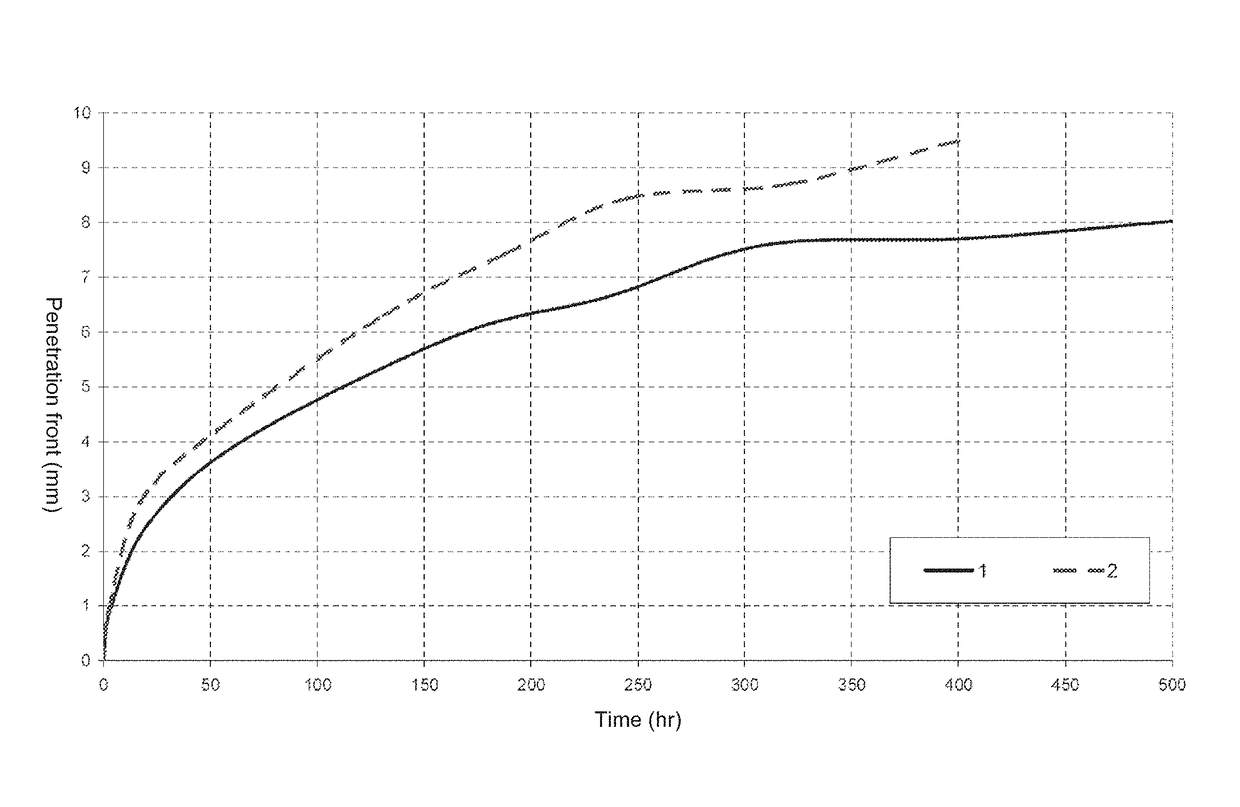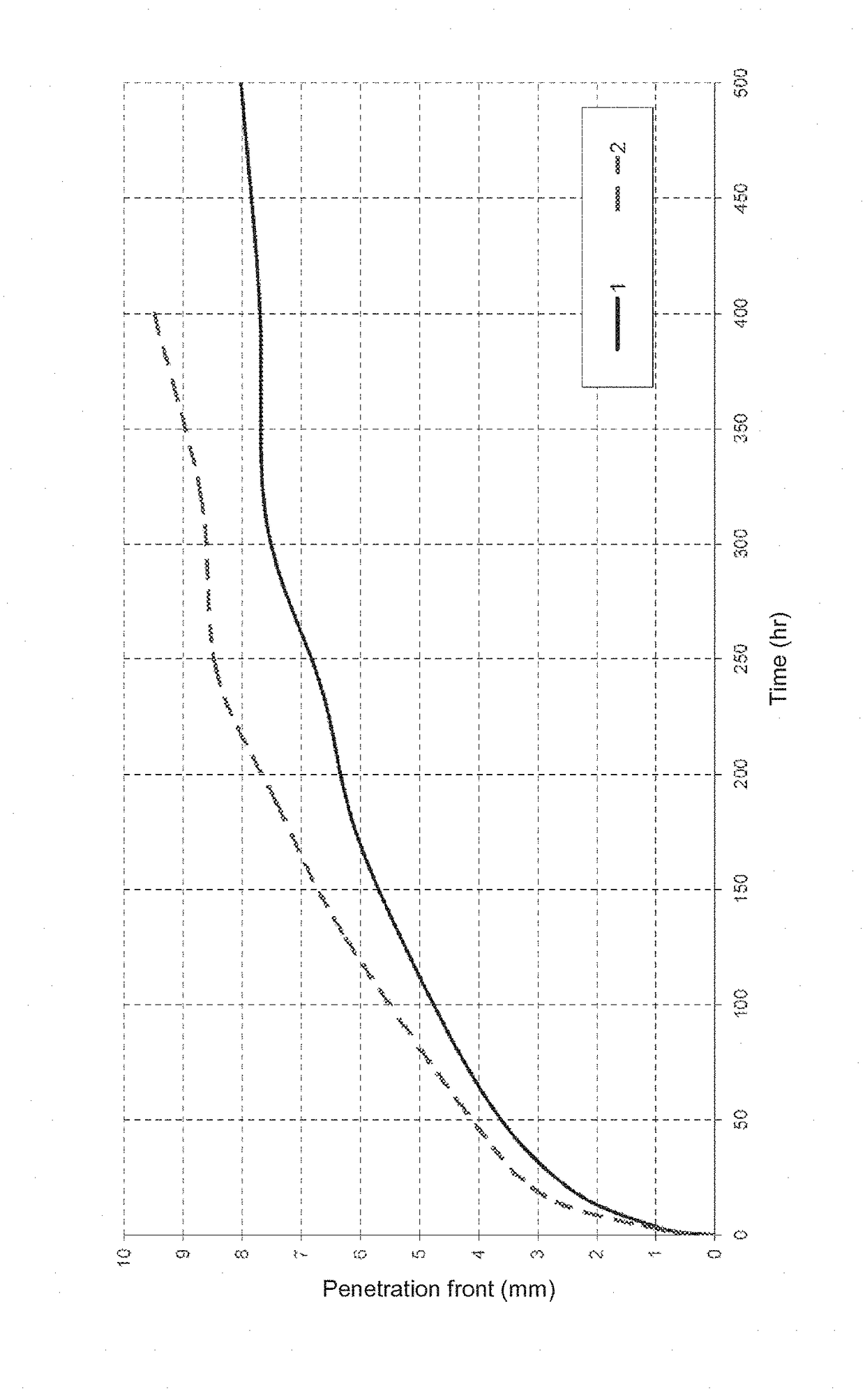Composite material for the protection of H2O sensitive devices based on surface functionalized nanozeolites dispersed in a polymeric matrix
a technology of surface functionalized nanozeolites and composite materials, applied in the field of composite materials for the protection of sensitive devices, can solve the problems of hsub>2/sub>o, traces, harmful to the correct operation of several devices, and progressive deterioration of their performance, so as to maximize the barrier properties, improve the barrier properties, and maximize the barrier properties
- Summary
- Abstract
- Description
- Claims
- Application Information
AI Technical Summary
Benefits of technology
Problems solved by technology
Method used
Image
Examples
example 1
[0045]7.74 grams of LTA 4A-POD previously activated through a thermal process at 240° C. under vacuum have been added to 31.36 grams of an Epo-tek OG 142-17 resin (single component commercial epoxy resin based on epichlorhydrin and bisphenol A), viscosity 300-500 cPa s, Tg 54° C. The composition (DGBEAepoxy—POD) has been thus pre-dispersed by means of simple mechanical stirring and subsequently made homogeneous using a so called 3 roll mill mixer. All the operations previously described have been carried out inside a chamber under dry nitrogen atmosphere (generally referred to as “glove box”).
[0046]A second composition (DGBEAepoxy—none) has been prepared similarly to the procedure above described, using 3.66 grams of non-organically functionalized LTA-4A and 14.50 grams of resin.
[0047]Glass-to-glass configurations (one for each composition) have been prepared under a moisture protected atmosphere by depositing 0.22 grams of dispensable material onto a surface of (2.54×6.00) cm2 in o...
example 2
[0049]230.8 grams of PMMA (Aldrich, MW 120000) were previously dissolved in 800 ml of Toluene anhydrous 99% (Aldrich). A clear viscous PMMA / Toluene suspension has been obtained under reflux heating at 80° C. for 30 minutes and mechanical stirring.
[0050]The composition PMMA—none prepared adding 1.90 grams of LTA 4A (previously activated 450° C. under vacuum) to 30.05 grams of PMMA / Toluene solution has been thus pre-dispersed by means of simple mechanical stirring and subsequently made homogeneous using a so-called 3 roll mill mixer. All the operations were carried out in glove box.
[0051]The glass to glass configurations were performed in glove box depositing the composite over a glass substrate 2.54×6.00×0.015 cm, and gently heated to 50° C. for 10 minutes to consolidate the film, then a cover glass was applied and the glass to glass sample were dried under vacuum at 80° C. for 6 hours until constant weight of the system was achieved.
[0052]Similarly, surface modified nanozeolite cont...
example 3
[0058]1.50 grams of LTA 4A-POD previously activated through a thermal process at 240° C. under vacuum have been added to 28.00 grams of an Epo-tek OG-603 resin (single component acrylic resin), viscosity 300-500 cPa s, Tg 54° C. The composition acrylic—POD has been thus pre-dispersed by means of simple mechanical stirring and subsequently made homogeneous using a so-called 3 roll mill mixer. All the operations previously described have been carried out inside a glove-box.
[0059]A second composition (acrylic—MCR) has been prepared similarly to the procedure as above described, using 1.05 grams of LTA-4A MCR and 20.03 grams of resin.
[0060]Glass-to-glass configurations (one for each composition) have been prepared under a moisture protected atmosphere by depositing 0.49 grams of dispensable material onto a surface of (2.54×6.00) cm2 followed by UV curing (10 sec, 100 mW / cm2, λ=250-400 nm).
[0061]The kinetic penetration levels of H2O under an exposure condition of the sample at 85° C. and...
PUM
| Property | Measurement | Unit |
|---|---|---|
| thicknesses | aaaaa | aaaaa |
| Tg | aaaaa | aaaaa |
| viscosity | aaaaa | aaaaa |
Abstract
Description
Claims
Application Information
 Login to View More
Login to View More - R&D
- Intellectual Property
- Life Sciences
- Materials
- Tech Scout
- Unparalleled Data Quality
- Higher Quality Content
- 60% Fewer Hallucinations
Browse by: Latest US Patents, China's latest patents, Technical Efficacy Thesaurus, Application Domain, Technology Topic, Popular Technical Reports.
© 2025 PatSnap. All rights reserved.Legal|Privacy policy|Modern Slavery Act Transparency Statement|Sitemap|About US| Contact US: help@patsnap.com


